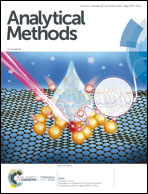Molecularly imprinted polymer functionalized reduced graphene oxide: a new platform for the detection of hydroxyl radicals in the atmosphere
Abstract
The hydroxyl radical (˙OH) is one of the most important oxidizing species in air whose concentration indicates the air quality. In this work, an indirect method was developed to determine ˙OH based on the electrochemical signal of 2,5-dihydroxybenzoic acid (2,5-DHBA), a specific reaction product of salicylic acid and ˙OH. The molecular imprinting technique was introduced into this work to improve the selectivity and sensitivity of this method. 2,5-DHBA was imprinted on reduced graphene oxide (rGO) via a simple electrochemical method by using pyrrole as the functional monomer. rGO not only provides abundant active sites for 2,5-DHBA imprinting but also improves the conductivity and mass transportation and increases the accessibility of active sites for 2,5-DHBA recognition. The differential pulse voltammetry (DPV) signals of 2,5-DHBA were used to evaluate the performance of the molecularly imprinted polymer (MIP) based sensor. The linear range for the concentration of 2,5-DHBA was from 5.0 × 10−8 to 4.5 × 10−5 M and the detection limit was down to 2.74 × 10−9 M. A linearity for ˙OH concentration ranging from 8.4 × 106 to 7.5 × 109 molecules per cm3 was obtained. The low detection limit for ˙OH was down to 4.6 × 105 molecules per cm3 when using this sensor. The atmospheric ˙OH concentration in Yangzhou has been successfully detected by this method. This work extended the molecularly imprinted polymers to the indirect detection of ˙OH in the atmosphere with a simplified sample collection and detection process and good sensitivity.



 Please wait while we load your content...
Please wait while we load your content...